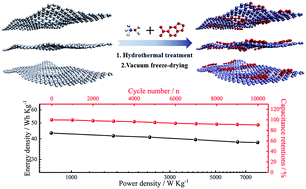Significantly boosting the energy storage capacity of N-doped graphene by non-covalent modification of fused heterocyclic small molecules†
Abstract
Organic molecules with multi-electron redox-active centers have great potential in the field of electrochemical energy storage. Fixing them on the surface of graphene can increase the pseudo-capacitance by enhancing the electronic interaction. However, the clues about how to screen suitable molecules to modify graphene and the effect of the type of substituents on the capacitive performance of graphene are not clear. In this paper, indole molecules with four different types of substituents (nitro, amino, hydroxyl, methoxy) were selected to modify N-doped graphene (5-NIFGN, 5-AIFGN, 5-HIFGN, 5-MIFGN) by a simple one-step hydrothermal method. Among the selected indole molecules, 5-aminoindole was found to be highly compatible with graphene. 5-AIFGN has the maximum specific capacitance and discharge capacity of 831.5 F g−1 and 277.2 mA h g−1 at 1 A g−1, respectively, and a long cycle life (reaching 91% after 5000 cycles). In further practical application evaluation, the symmetrical device based on the 5-AIFGN electrode achieved an energy density of 38.0–43.4 W h kg−1 and a power density of 800–8000 W kg−1. Our work provides an efficient route for the design of high-performance organic electrode materials by properly designing the structure of organic molecules to enhance their adsorption affinity and electronic interaction with graphene, thus increasing the contribution of pseudo-capacitance.



 Please wait while we load your content...
Please wait while we load your content...